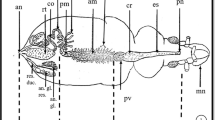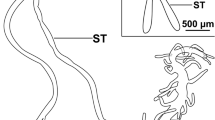Abstract
In this study, morphological and histological studies of the alimentary canal and associated salivary gland and Malpighian tubules were conducted for the firebug Pyrrhocoris apterus (Hemiptera: Pyrrhocoridae), which is their diets are mainly linden trees and mallows. Understanding its digestive process will help elucidate the ecological and economical significance of this species. Therefore, the insects were dissected to examine all the sections under stereomicroscope, light and scanning electron microscopies. Morphological and histological results show that the salivary glands of P. apterus find in the thorax of the insect with a pair of principal glands, a pair of accessory glands, a pair of principal canals and a pair of accessory canals. The alimentary canal is divided into three regions: foregut, midgut, and hindgut. The foregut consists of oral cavity, pharynx, esophagus, and proventriculus. The esophagus consists of a long tube and is surrounded by a layer of longitudinal muscle. The proventriculus is formed by a single layer of columnar cells with oval nuclei surrounded by a layer of muscles. The midgut is divided into four regions: the first, second, third, and fourth ventriculi. The midgut is composed of monolayer epithelial cells surrounded by muscles. P. apterus midgut lacks gastric caeca. The hindgut has a pylorus followed by a well-developed rectum. The wall of the rectum is surrounded by a single layer cubic epithelium which has deep infoldings. There is a pair of Malpighian tubules linked at each side of mediolateral of pylorus. Malpighian tubules consist of two regions as proximal and distal. Malpighian tubules consist of a monolayer cuboidal epithelium with cubic nuclei in middle.











Similar content being viewed by others
References
Ahmad I, Schaefer CW (1987) Food plants and feeding biology of the Pyrrhocoroidea (Hemiptera). Phytophaga 1:75–92
Al-Sandouk NM (1977) The histology of the midgut epithelium of Oncopeltus fasciatus Dallas (Hemiptera: Lygaeidae). Imperial College of Science and Technology, University of London, London, Department of Zoology and Applied Entomology
Azevedo DDO, Zanuncio JC, Zanuncio JS Jr, Martins GF, Marques-Silva S, Sossai MF, Serrão JE (2007) Biochemical and morphological aspects of salivary glands of the predator Brontocoris tabidus (Heteroptera: Pentatomidae). Braz Arch Biol Techn 50(3):469–477
Baptist BA (1941) The morphology and physiology of the salivary glands of Hemiptera-Heteroptera. J Cell Sci 2(329):91–139
Barber B, Lynita MC, Abell DW (1980) A study of the anatomy of the alimentary canal of Brochymena quadripustulata (Hemiptera: Pentatomidae). JASS 34:16–18
Barber HG (1911) Descriptions of some new Hemiptera-Heteroptera. J N Y Entomol Soc 19(1):23–31
Billingsley PF (1990) The midgut ultrastructure of hematophagous insects. Annu Rev Entomol 35:219–248
Burgos MH, Gutierrez LS (1976) The intestine of Triatoma infestans. I. cytology of the midgut. J Ultrasctruct Res 57:1–9
Castellanos N, Martinez LC, Silva EH, Teodoro AV, Serrao JE, Oliveira EE (2017) Ultrastructural analysis of salivary glands in a phytophagous stink bug revealed the presence of unexpected muscles. PLoS One 12(6):1–15
Chapman RF (1998) Alimentary canal, digestion and absorption. In: Simpson SJ, Douglas AE (eds) The insect: structure and function. Cambridge University, United Kingdom, pp 38–68
Chapman RF (2013) Structure of the digestive system. In: Kerkut GA, Gilbert LI (eds.). Comprehensive insect physiology biochemistry and pharmacology, regulation: digestion, nutrition, excretion, Pergamon Press, 165–212.
Cicero JM, Brown JK, Roberts PD, Stansly PA (2009) The digestive system of Diaphorina citri and Bactericera cockerelli (Hemiptera: Psyllidae). Ann Entomol Soc Am 102(4):650–665
Coast GM, Nachman RJ, Lopes J (2011) The control of Malpighian tubule secretion in a predacious hemipteran insect, the spined soldier bug Podisus maculiventris (Heteroptera, Pentatomidae). Peptides 32:493–499
Cossolin JFS, Martínez LC, Pereira MJB, Vivan LM, Bozdoğan H, Fiaz M, Serrão JE (2019) Anatomy, histology, and ultrastructure of salivary glands of the burrower bug, Scaptocoris castanea (Hemiptera: Cydnidae). Microsc Microanal 25(6):1482–1490
Dai L, Yang B, Wang J, Zhang Z, Yang R, Zhang T, Ren Z, Lin C (2019) The anatomy and ultrastructure of the digestive tract and salivary glands of Hishimonus lamellatus (Hemiptera: Cicadellidae). J Insect Sci 19(4):3,1–9.
De Castro AA, Canevari GD, Pikart TG, Ribeiro RC, Serrão JE, Zanuncio TV, Zanuncio JC (2013) Salivary gland histology of the predator Supputius cincticeps (Heteroptera: Pentatomidae). Ann Entomol Soc Am 106(2):273–277
Dillon RJ, Dillon VM (2004) The gut bacteria of insects: nonpathogenic interactions. Annu Rev Entomol 49(1):71–92
Elson JA (1937) A comparative study of the Hemiptera. Ann Entomol Soc Am 30:579–597
Fialho MDCQ, Zanuncio JC, Neves CA, Ramalho FS, Serrão JE (2009) Ultrastructure of the digestive cells in the midgut of the predator Brontocoris tabidus (Heteroptera: Pentatomidae) after different feeding periods on prey and plants. Ann Entomol Soc Am 102(1):119–127
Guedes BA, Zanuncio JC, Ramalho FS, Serrão JE (2007) Midgut morphology and enzymes of the obligate zoophytophagous stinkbug Brontocoris tabidus (Signoret, 1863) (Heteroptera: Pentatomidae). Pan-Pac Entomol 83(1):66–74
Habibi J, Coudron TA, Backus EA, Brandt SL, Wagner RM, Wright MK, Huesing JE (2008) Morphology and histology of the alimentary canal of Lygus hesperus (Heteroptera: Cimicomoropha: Miridae). Ann Entomol Soc Am 101(1):159–171
Hamner AL (1936) The gross anatomy of the alimentary canal of Solubea pugnax Fab. Ohio J Sci 36:157–160
Haridass ET, Ananthakrishnan TN (1981) Functional morphology of pylorus and rectal glands in Reduviidae (Insecta-Heteroptera). Proc Indian Acad Sci 90(4):483–493
Harris CS (1938) The anatomy and histology of the alimentary system of the harlequin cabbage bug, Murgantia histrionica Hahn. (Hemiptera, Pentatomidae). Ohio J Sci 38(6):316–331.
Henry TJ (1988) Family Pyrrhocoridae Fieber, 1860. Henry TJ, Froeschner RC(eds) Catalogue of the Heteroptera, or true bugs, of Canada. The Continental United States, Brill, Leiden, pp 613–615
Hood CW (1937) The anatomy of the digestive system of Oncopeltus fasciatus Dall. (Heteroptera: Lygaeidae). Ohio J Sci 37(3):151–160.
Honӗk A (1974) Wing polymorphism in Pyrrhocoris apterus (L.) (Heteroptera: Pyrrhocoridae): influence of photoperiod. VČst ýs Spol Zool 38:241–242
Kerzhner IM (2001) Family Pyrrhocoridae Amyot & Serville, 1843. Aukema B, Rieger C(eds) Catalogue of Heteroptera of the Palearctic Region, vol 4. Entomological Society, Amsterdam, The Netherlands, pp 248–258
Korcz A (1994) Firebug-pest or useful insect? Ochrona Roslin 38:6–7
Kristenova M, Exnerova A, Štys P (2011) Seed preferences of Pyrrhocoris apterus (Heteroptera: –Pyrrhocoridae): Are there specialized trophic populations? Eur J Entomol 108:581–586
Lehane MJ, Billingsley PF (1996) Biology of the insect midgut. Chapman & Hall, London
Lipowa I, Lipa JJ (1957) Observation of the firebug’s (Pyrrhocoris apterus L.) feeding behaviour and its host plants. Biul Inst Ochr Rosl 2:99–206
Martini SV, Nascimento SB, Morales MM (2007) Rhodnius prolixus Malpighian tubules and control of diuresis by neurohormones. An Acad Bras Ciênc 79(1):87–95
Massee AM (1954) The Hemiptera-Heteroptera of Kent. Trans Soc Brit En 11(12):245–280
Meguid AA, Awad HH, Omar AH, Elelimy HA (2013) Ultrastructural study on the midgut regions of the milkweed bug, Spilostethus pandurus Scop.(Hemiptera: Lygaeidae). Asian J Biol Sci 6(1):54–66.
Mehrabadi M, Bandani AR, Allahyari M, Serrao JE (2012) The Sunn pest, Eurygaster integriceps Puton (Hemiptera: Scutelleridae) digestive tract: histology, ultrastructure and its physiological significance. Micron 43:631–637
Mello MLS, Dolder H (1977) Fine structure of the Malpighian tubes in the blood-sucking insect, Triatoma infestans Klug. Protoplasma 93:275–288
Özyurt N, Amutkan D, Polat I, Kocamaz T, Candan S, Suludere Z (2017) Structural and ultrastructural features of the Malpighian tubules of Dolycoris baccarum (Linnaeus 1758) (Heteroptera: Pentatomidae). Microsc Res Techniq 80(4):357–363
Pluot D (1978) Données sur Scantius aegyptius, Hémiptère Pyrrhocoride paléarctique, comparaison avec Pyrrhocoris apterus. Ann Soc Entomol Fr 14:703–713
Puchkov VG (1974) New Miridae (Heteroptera) from the Turkmenian SSR Fauna. Vest Zool 73–79.
Rigoni GM, Conte H (2014) Malpighian tubules in larvae of Diatraea saccharalis (Lepidoptera; Crambidae): a morphological comparison between non-parasitized and parasitized by Cotesia flavipes (Hymenoptera; Braconidae). AE, 2:202–210.
Rocha LLV, Neves CA, Zanuncio JC, Serrão JÉ (2010) Digestive cells in the midgut of Triatoma vitticeps (Stal, 1859) in different starvation periods. Cr biol 333(5):405–415
Schlagbauer A (1966) Eine Methode zur Massen-und Dauerzucht der Feuerwanze, Pyrrhocoris apterus Linnaeus (Heteroptera: Pyrrhocoridae). Beiträge zur Entomologie 16(1–2):199–202
Silva CP, Ribeiro AF, Gulbenkian S, Terra WR (1995) Organization, origin and function of the outer microvillar (perimicrovillar) membranes of Dysdercus peruvianus (Hemiptera) midgut cells. J Insect Physiol 41(12):1093–1103
Stehlík JL, Heiss E (2000) Results of the investigations on Hemiptera in Moravia made by the Moravian Museum (Aradidae, Pyrrhocoridae). Acta Mus Mor Sci Biol 85:333–350
Socha R (1993) Pyrrhocoris apterus (Heteroptera)–an experimental model species: a review. Eur J Entomol 90:241–286
Socha R, Šula J (1996) Differences in haemolymph proteins in relation to diapause and wing dimorphism in Pyrrhocoris apterus (Heteroptera: Pyrrhocoridae). J Comp Physiol (B) 166:382–387
Terra WR, Ferreira C (2009) Digestive system. Resh VS. Academic press, Cardé RT(eds) Encyclopedia of insects, pp 273–281
Terra WR (1990) Evolution of digestive systems of insects. Annu Rev Entomol 35:181–200
Terra WR, Ferreira C (2012) Biochemistry and molecular biology of digestion. Gilbert LI(ed) Insect molecular biochemistry biochemistry. Academic press, Elsevier, Oxford, pp 171–224
Tischler W (1959) Zur Biologie der Feuerwanze (Pyrrhocoris apterus L.). Zool Anz 163:392–396
Uceli LF, Pirovani VD, de Freitas Vicente NM, Pikart TG, Ferreira PSF, Serrao JE (2011) Morphology of the reproductive and digestive tracts of Adparaproba gabrieli (Heteroptera: Miridae. Int J Trop Insect Sc 31(4):219–224
Walker GP (2009) Salivary glands. Resh VS, Cardé RT(eds). Academic press, Encyclopedia of insects, pp 897–901
Xie Y, Liu W, Zhang Y, Xiong Q, Xue J, Zhang X (2011) Morphological and ultrastructural characterization of the alimentary canal in Japanese wax scale (Ceroplastes japonicus Green). Micron 42(8):898–904
Yazdanian M, Farshbaf Pourabad R, Rashidi MR, Valizadeh M, Rashtchizadeh N (2006) Morphology of the gut and salivary gland of the stripped bug, Graphosoma lineatum (L.) (Het., Scutelleridae). J Agric Sci 16(2):77–90.
Acknowledgments
The author would like to thank Prof. Dr. Selami Candan (Department of Biology, Science Faculty, Gazi University, Ankara, Turkey) for his valuable insights and recommendations for the article. In addition, the author’s thanks are also extended to Gazi University Academic Writing Center for the proofreading of this paper.
Author information
Authors and Affiliations
Corresponding author
Ethics declarations
Informed consent
This article was originally submitted by the author in English and has not been submitted for publication elsewhere.
Additional information
Publisher's Note
Springer Nature remains neutral with regard to jurisdictional claims in published maps and institutional affiliations.
Rights and permissions
About this article
Cite this article
Özyurt Koçakoğlu, N. Morphology and histology of the alimentary canal, salivary glands and Malpighian tubules in Pyrrhocoris apterus (Linnaeus, 1758) (Hemiptera: Pyrrhocoridae): a scanning electron and light microscopies study. Int J Trop Insect Sci 41, 1845–1862 (2021). https://doi.org/10.1007/s42690-021-00530-7
Received:
Accepted:
Published:
Issue Date:
DOI: https://doi.org/10.1007/s42690-021-00530-7




